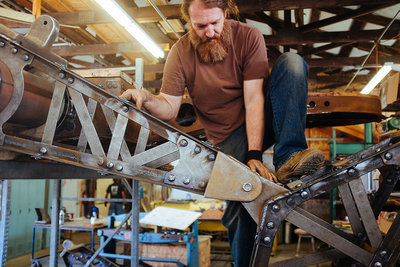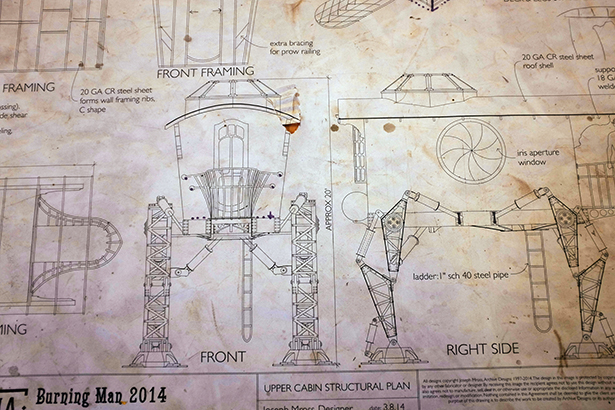
For a man currently wedged between a rock and that proverbial hard place, Eugene artist Joe Mross appears surprisingly serene. Here’s the deal: Mross, a metalsmith and perhaps this town’s foremost purveyor of the steampunk aesthetic, has but a handful of days to complete the grandest and most ambitious project of his life thus far — a 5,000-plus lbs. metallurgic behemoth of rivets, Plexiglas, fabricated steel and sandblasted wood that must be trucked down and set up for Nevada’s legendary Burning Man festival by Aug. 25.
“This is huge,” Mross tells me as we stand together inside his studio, beholding a work-in-progress that looks risen from the fevered dreams of Terry Gilliam and H.R. Giger. Mross fixes me with kind and vaguely bemused eyes. “This is the most complex piece I’ve ever built and designed,” he says, smiling through the grit creased into his face. “The stage we’re at we should have been at two months ago.”
Even half-finished and standing propped on one leg in the middle of the studio, the piece Mross and crew are constructing is awesome to behold. “Lost Nomads of Vulcania” is a fantasy geek’s wet dream. Described by Mross as a “gypsy encampment featuring the Teluriz, one of the few remaining Vardo Class Steam Walkers built by the last surviving members of Captain Nemo’s crew,” this exotically majestic structure resembles the AT-AT snow walkers that attack Hoth at the beginning of The Empire Strikes Back. “Lost Nomads” is at once pre- and post-apocalyptic, and its functional artistry blooms from some halted intersection of modernity and the early industrial revolution, where rococo complexity is rusted shut by the melancholy price of progress. It’s a magnificent work of art.
To help finance the installation, Mross was granted one of Burning Man’s rare honorariums, in which the festival offers a chunk of ticket revenues to support select art projects that are collaborative, interactive and community-oriented. And the term honorarium is apt: Most artwork at the fest is unfunded, and the grant is a nod to the magnitude of Mross’ vision. He says that the Teluriz represents the culmination of everything he’s learned so far in his career, starting with high-school metal shop and an arts degree at the University of Oregon, up through the commissioned metalwork he’s sent around the globe as the proprietor of Archive Designs.
“I built a model with great detail,” he says of the to-scale computer design for “Lost Nomads” he originally created in January, followed by the detailed blueprints he sent to Burning Man in March.
“It’s just a gigantic prop, really,” Mross continues, “but built authentically. I really want people who know something about metalwork to see it. It’s period work, but it’s from an alternate period,” he says, explaining his steampunk aesthetic and the construed mythology inherent to the piece. “There’s a lot of flexibility.”
Apart from its sheer size, it’s the filigreed flourishes and insider details that reveal the high degree of passion and sophistication Mross has applied in creating “Lost Nomads” — touches like the “TK-421” he’s etched lightly into the metal foot-base, the serial code for the suit Luke Skywalker stole from an Imperial Stormtrooper in Star Wars. It’s Easter eggs such as this, along with the fact that Mross and his rotating volunteer crew of nearly 20 people (eight of whom will travel with him to Burning Man) have fabricated nearly every piece of steel for the installation, that give this nouveau-archaic structure such a heightened sense of reality.
“I’m definitely in awe of it,” says Elizabeth Anderson, the project manager Mross recently brought on board. Like many of the volunteers helping Mross, Anderson has spent her free time doing things like pounding bolt heads to give them that distressed steampunk look. “It’s just really amazing he can make all these parts,” she says.
 |
| Plans for ‘Lost Nomads of Vulcania’ |
As he stands before “Lost Nomads,” Mross himself seems humbled by the scope of his own creation. “I haven’t seen anything like this,” he says of past installations at Burning Man. “This is going to be one of the things out there that people are going to say, ‘That was one of my favorite spots to hang out.’”
Of course, simply transporting such an enormous work of art into the Nevada desert represents its own difficulties. According to Anderson, the crew will drive the Teluriz in pieces and install it on-site. “To do this, we’re hauling most of our gear, tools and the legs of the Teluriz in a big-box moving truck,” she explains, adding that the main body of the Teluriz will be pulled behind the truck in a flatbed trailer.
And what’s to become of the Teluriz once the dust of Burning Man settles? Anderson says she and Mross have been thinking a lot about what to do with it. “It will definitely be an attraction, and we’d like to let the Teluriz travel a little bit,” she says. “It’s exciting and interactive, and we’d love to have it take a little tour around Oregon and beyond.”